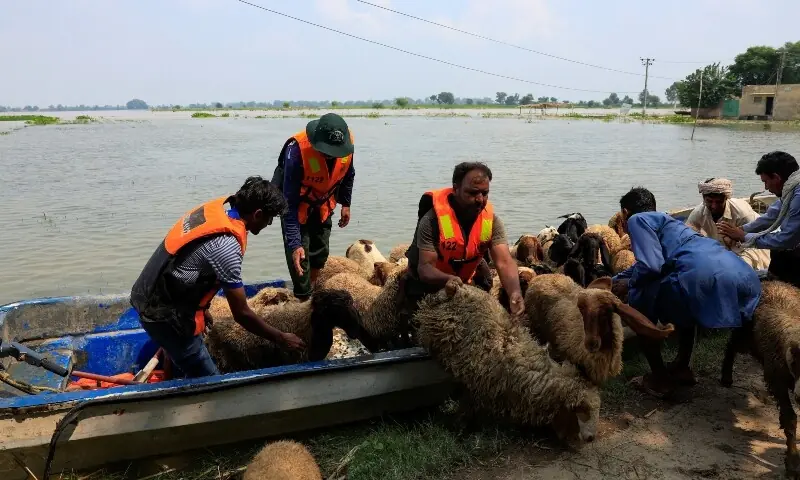
The National Disaster Management Authority (NDMA) on Tuesday issued a high-flood alert for the Ravi River after India released additional water into the tributary.
A devastating monsoon season marked by record rainfall, glacier melt, and widespread flooding has exposed Pakistan’s extreme vulnerability to climate change. The “high flood” warnings this week have put Punjab on high alert and prompted mass evacuations in various places.
In a high flood alert posted at 5:40pm, the NDMA said: “Heavy rainfall expected in the upper regions of Ravi over the next 48 hours. The Indian dam Thein is 97 per cent full, and its spillways may be opened at any time. Due to potential discharge, a high-level flood is expected in the Ravi River. High-level flow is also expected in Pir Panjal, Bain, Basantar and Deek.”
The NDMA cautioned citizens to stay away from rivers, drains and low-lying areas, along with avoiding unnecessary travel.
It also issued instructions to agencies and emergency services to remain on high alert.
A statement from the Punjab Provincial Disaster Management Authority (PDMA) said India had opened all gates of the Thein Dam on the Ravi River and 210,000 cusecs of water were entering Pakistan from Kot Ninan.
“In the next 24 hours, the water flow at Kot Ninan will increase further. In the next 48 hours, very high level of flood will pass through Jasar Shahdara and Head Baloki,” it said, adding that the Lahore commissioner and deputy commissioners of other districts had been alerted.
The PDMA spokesperson said the water level in the Ravi River was continuously increasing, adding that there was a high level of flood at Jasar with 142,000 cusecs of water continuously entering and a low level of flood at Shahdara at 56,000 cusecs of water.
The spokesperson said the PDMA had instructed the administration of the districts adjacent to the Ravi River to take emergency measures and instructions were issued for the immediate evacuation of citizens in the river’s basin.
Meanwhile, an update from Kasur Division Signaller Ghulam Mustafa at 8pm said there was a “very high flood” in the Sutlej River with the flow at 208,973 cusecs and rising.
Earlier today, state-run APP reported that nearly 150,000 people have so far been relocated to safer areas from flood-prone regions, adding that it followed early warnings and alerts issued by NDMA regarding rising water levels and potential flooding.
The PDMA initiated “large-scale evacuation operations” in vulnerable places following the swelling of the Sutlej River, the report said.
“Emergency response teams were deployed, and all concerned departments were placed on high alert to safeguard public life and property,” it added.
The data provided by the NDMA showed evacuations included 89,868 residents from Bahawalnagar, 14,140 from Kasur, 2,063 from Okara, 873 from Pakpattan, 361 from Bahawalpur, and 165 from Vehari, according to the APP.
It further said that around 40,000 people had moved to safer locations soon after the initial alerts.
A day earlier, Punjab Chief Minister Maryam Nawaz issued orders to evacuate the people living in areas around rivers and low-lying regions, while the Ministry of Climate Change predicted heavy rains in Gujranwala, Gujrat, and Lahore divisions “with a high risk of both riverine and urban flooding”.
An alert by Punjab PDMA on Monday reported “high flood level” in the Sutlej River at 10am, urging district administrations across Punjab to maintain a “high level of preparedness and mitigation of the disaster”.
The Pakistan Meteorological Department (PMD) also issued a flood warning for the Chenab River and Ravi River yesterday, stating that the intensity of rainfall over the eastern rivers was “likely to increase significantly”.
In light of a flood alert by India, more than 24,000 people had been relocated from the low-lying areas of the Indus, Chenab, Ravi, and Sutlej rivers since Saturday, according to Rescue 1122 spokesperson Farooq Ahmad.
